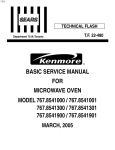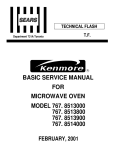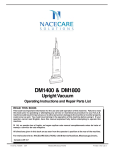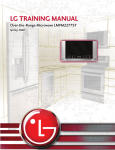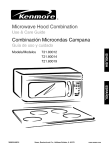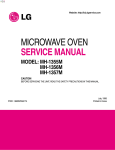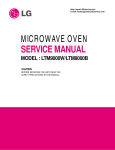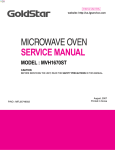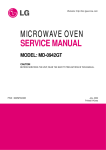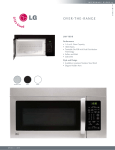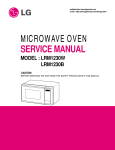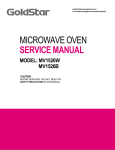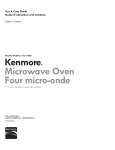Download MICROWAVE OVEN SERVICE MANUAL
Transcript
삼 정 흥 판 Website: http://us.lgservice.com MICROWAVE OVEN SERVICE MANUAL MODEL: LMV1630WW LMV1630BB LMV1630ST CAUTION BEFORE SERVICING THE UNIT, READ THE SAFETY PRECAUTIONS IN THIS MANUAL. P/NO : 382885S0009 January, 2006 Printed in Korea CAUTION WARNING TO SERVICE TECHNICIANS PRECAUTIONS TO BE OBSERVED BEFORE AND DURING SERVICING TO AVOID POSSIBLE EXPOSURE TO EXCESSIVE MICROWAVE ENERGY a. Do not operate or allow the oven to be operated with the door open. b. Make the following safety checks on all ovens to be serviced before activating the magnetron or other microwave source, and make repairs as necessary; (1) Interlock operation, (2) proper door closing, (3) seal and sealing surfaces (arcing, wear, and other damage), (4) damage to or loosening of hinges and latches, (5) evidence of dropping or abuse. c. Before turning on microwave power for any service test or inspection within the microwave generating compartments, check the magnetron, wave guide or transmission line, and cavity for proper alignment, integrity, and connections. d. Any defective or misadjusted components in the interlock, monitor, door seal, and microwave generation and transmission systems shall be repaired, replaced, or adjusted by procedures described in this manual before the oven is released to the owner. e. A Microwave leakage check to verify compliance with the Federal performance standard should be performed on each oven prior to release to the owner. • Proper operation of the microwave ovens requires that the magnetron be assembled to the wave guide and cavity. Never operate the magnetron unless it is properly installed. • Be sure that the magnetron gasket is properly installed around the dome of the tube whenever installing the magnetron. • Routine service safety procedures should be exercised at all times. • Untrained personnel should not attempt service without a thorough review of the test procedures and safety information contained in this manual. FOREWORD Read this Manual carefully. Failure to adhere to or observe the information in this Manual may result in exposing yourself to the Microwave Energy normally contained within the oven cavity. TABLE OF CONTENTS (Page) SAFETY PRECAUTIONS ................................................................................................................Inside front page SPECIFICATIONS ................................................................................................................................................ 1-1 CAUTIONS ........................................................................................................................................................... 2-1 INSTALLATIONS .................................................................................................................................................. 3-1 OPERATING INSTRUCTIONS............................................................................................................................. 4-1 CONTROL PANEL .......................................................................................................................................... 4-1 CONTROL PANEL INSTRUCTIONS............................................................................................................... 4-2 OVERALL CIRCUIT DIAGRAM ............................................................................................................................ 5-1 SCHEMATIC DIAGRAM .................................................................................................................................. 5-1 MATRIX CIRCUIT FOR TOUCH KEY BOARD ............................................................................................... 5-2 GENERAL INFORMATION FOR SERVICE ......................................................................................................... 6-1 GENERAL PRECAUTIONS IN USE ............................................................................................................... 6-1 TRIAL OPERATION ........................................................................................................................................ 6-1 FEATURES AND SPECIFICATIONS FEATURES .......................................................................................... 6-1 SERVICE INFORMATION .................................................................................................................................... 7-1 PRECAUTIONS AND REPAIR SERVICE TIPS .............................................................................................. 7-1 MICROWAVE LEAKAGE TEST ...................................................................................................................... 7-2 POWER OUTPUT MEASUREMENT............................................................................................................... 7-3 DISASSEMBLY INSTRUCTIONS ................................................................................................................... 7-4 INTERLOCK SYSTEM .................................................................................................................................. 7-11 INTERLOCK CONTINUITY TEST ................................................................................................................. 7-13 TEST AND CHECKOUT PROCEDURES AND TROUBLESHOOTING........................................................ 7-14 A. TEST PROCEDURES ........................................................................................................................... 7-14 B. CHECKOUT PROCEDURES ................................................................................................................ 7-19 C. TROUBLESHOOTING .......................................................................................................................... 7-21 EXPLODED VIEW ................................................................................................................................................ 8-1 REPLACEMENT PART LIST................................................................................................................................ 9-1 SPECIFICATIONS Rated Power Consumption ................................ 1500W maximum (Microwave oven+Cook top lamps+Ventilation fan) Microwave Output ............................................... 1000W (IEC60705) Frequency .......................................................... 2450 MHz ±50 MHz Power Supply ..................................................... 120 VAC, 60 Hz Rated Current .................................................... 14 Amp. (Microwave oven+Cook top lamps+Ventilation fan) Magnetron Cooling ............................................. Forced Air Cooling Rectification ....................................................... Rectification Voltage Double Half-Wave Door Sealing ...................................................... Choke System Safety Devices ................................................... Oven Thermostat: Open at 90 °C ± 5 °C Close at 0 °C ± 5 °C ............................................................................ Fuse(20A) ............................................................................ Primary Interlock Switch ............................................................................ Secondary Interlock Switch ............................................................................ Interlock Monitor Switch Magnetron .......................................................... 2M214 - 161GP Cook top Lamp ................................................... 120 V, 30 W Cavity Lamp ....................................................... 125 V, 30 W or 40 W Timer .................................................................. Digital, up to 99 min. 99 sec. (in each cooking stage) Tray .................................................................... Tempered Safety Glass Overall Dimensions ............................................ 2915/16”(W)x167/16”(H)x171/8”(D) Oven Cavity Size ............................................... 207/8”(W)x93/16”(H)x143/16”(D) Effective Capacity of Oven Cavity ...................... 1.6 Cu.ft. Accessories ........................................................ Owner’s Manual & Cooking Guide, Installation Manual, ............................................................................ Exhaust Adapter, Exhaust Damper, Mounting Kit and Filter, ............................................................................ Glass Tray, Metal Rack, Rotating Ring Assembly. SWITCH CHART SWITCH MODE CONDITIONS DOOR OPEN DOOR CLOSED PRIMARY INTERLOCK SWITCH SECONDARY INTERLOCK SWITCH INTERLOCK MONITOR SWITCH COM NO OPEN CLOSE COM NO OPEN CLOSE COM NC CLOSE OPEN NOTE: Use the above switch chart with circuit diagram on page 5-1. 1-1 CAUTIONS Unlike other appliances, the microwave oven is high-voltage and high-current equipment. Though it is free from danger in ordinary use, extreme care should be taken during repair. MICROWAVE RADIATION Personnel should not be exposed to the microwave energy which may radiate from the magnetron or other microwave generating device if it is improperly used or connection. All input and output microwave connections, waveguide, flange, and gasket must be secure never operate the device without a microwave energy absorbing load attached. Never look into an open waveguide or antenna while the device is energized. • DO NOT operate on a 2-wire extension cord during repair and use. • NEVER TOUCH any oven components or wiring during operation. • BEFORE TOUCHING any parts of the oven, always remove the power plug from the outlet. • Remove your watches whenever working close to or replacing the Magnetron. • DO NOT touch any parts of the control panel circuit. A resulting static electric discharge may damage this P.C.B. • NEVER operate the oven with no load. • NEVER injure the door seal and front plate of the oven cavity. • NEVER put iron tools on the magnetron. • NEVER put anything into the latch hole and the interlock switches area. • Proper operation of the microwave oven requires that the magnetron be assembled to the waveguide and cavity. Never operate the magnetron unless it is properly installed. • Be sure that the magnetron gasket is properly installed around the dome of the tube whenever installing the magnetron. ANTENNA Gasket COOLING FIN MAGNETRON CHASSIS GROUND FILAMENT TERMINALS MAGNETRON THE OVEN IS TO BE SERVICED ONLY BY PROPERLY QUALIFIED SERVICE PERSONNEL. 2-1 INSTALLATIONS BEFORE YOU BEGIN, READ THE FOLLOWING INSTRUCTIONS COMPLETELY AND CAREFULLY. PRECAUTIONS ON INSTALLATION A. Plug the power supply cord into a 120V AC, 60Hz, single-phase power source with a capacity of at least 20 amperes. B. Avoid placing the unit in a location where there is direct heat or splashing water. C. Install the unit on the mounting plate firmly. D. Place the unit as far away as possible from TV, radio, etc. to prevent interference. GROUNDING INSTRUCTIONS For personal safety, this appliance must be fully grounded at all times. In the event of an electrical short circuit, grounding reduces the risk of electrical shock. The plug must be plugged into an outlet that is properly installed and grounded. CAUTION This unit is equipped with a 3-prong plug for your safety. If the wall outlet is a grounded 3-hole type, the unit will be grounded automatically. WARNING Improper use of the grounding plug can result in a risk of electric shock. Do not, under any circumstances, cut or remove the third ground prong from the power cord plug. 3-1 OPERATING INSTRUCTIONS CONTROL PANEL 4-1 CONTROL PANEL INSTRUCTIONS 1. DISPLAY: The Display includes a clock and indicators to tell you time of day, cooking time settings and cooking functions selected. 14. POPCORN: Touch this pad when popping popcorn in your microwave oven. 15. MELT: Touch this pad to melt butter or margarine, chocolate, cheese, marsh mallow. 2. COOK: Touch this pad to cook fresh vegetable, frozen vegetable, rice, or casseroles. 16. SOFTEN: Touch this pad to soften butter, ice cream, cream cheese, frozen juice. 3. REHEAT: Touch this pad to reheat dinner plate, soup/sauce, casserole, roll/muffin. 4. KIDS MEAL: Selects type of dish to reheat hot dog, baby food, oat meal or soup. 17. HOLD WARM: Touch this pad to keep hot, cooked foods warm in your microwave oven for up to 99 minutes 99 seconds. 5. AUTO DEFROST: Meat, poultry, fish. Touch this pad to select food type and defrost food by weight. 18. KITCHEN TIMER: Touch this pad to set the kitchen timer. 6. QUICK DEFROST: This pad provides you with the RAPID defrosting method for 1.0 pound frozen foods. 19. START: Touch this pad to start a function. If you open the door after oven begins to cook, retouch START. 7. TIME COOK: Touch this pad to set a cooking time. 20. STOP/CLEAR: Touch this pad to stop the oven or clear all entries. 8. CLOCK: Touch this pad to enter the time of day. 21. LESS: Touch this pad to subtract ten seconds of cooking time each time you press it. 9. NUMBER: Touch number pads to enter cooking time, power level, quantities or weights. 22. Ez-ON: Touch this pad to set and start quickly at 100% power level. 10. MORE: Touch this pad to add ten seconds of cooking time each time you press it. 23. TURNTABLE ON/OFF: Touch this pad to control the turntable on or off. 11. POWER LEVEL: Touch this pad to select a cooking power level. 24. LIGHT HI/LOW/OFF: Touch this pad to turn the cooktop/countertop light on or off. 12. LIGHT HI/LOW/OFF: Touch this pad to turn the Vent on or off. 13. HOT WATER: Touch this pad when heating water in your microwave oven. 4-2 OVERALL CIRCUIT DIAGRAM SCHEMATIC DIAGRAM 5-1 MATRIX CIRCUIT FOR TOUCH KEY BOARD KEY MATRIX 5-2 GENERAL INFORMATION FOR SERVICE GENERAL PRECAUTIONS IN USE FEATURES AND SPECIFICATIONS FEATURES A. Never operate the unit when it is empty. Operating the oven with no load may shorten the life of the magnetron. Whenever cooking dry foods (dried fish, bread, etc.)or a small amount of food, be sure to put a glass of water into the cooking compartment. The glass turntable may become hot after operating, be careful when touching it. B. Aluminum foil should be avoided because it will disrupt cooking and may cause arcing. However, small pieces may be used to cover some parts of food to slow the cooking. Any aluminum foil used should never be closer than 2.5 cm to any side wall of the oven. A. The safety systems incorporated in this model are: (1) Primary interlock switch (2) Secondary interlock switch (3) Interlock monitor switch (4) Choke system (5) Oven cavity thermostat (Note This thermostat located on the oven cavity will open and stop the unit from operation only if a high temperature is reached, such as, a fire created by overcooking food.) B. Any one of 10 power output levels ranging 0W to 1000W can be selected by the touch control and electronic computer system. C. Cooking time can be displayed on the digital readout. D. Three different cooking stages (Include Defrost) can be changes from one cooking stage to another. This is made possible with the memory function of the microprocessor. TRIAL OPERATION After installation, the following sequences and results should be checked carefully. A. Put a container filled with water (about 1 liter)into the oven, and close the door tightly. B. Set cooking time for 10 minutes by touching “1 ” and then “0” three times.“1, 0, 0, 0” appears in the display window. C. Touch the START key. Make sure the cavity light comes on. The unit will begin cooking and the display window will show the time counting down by seconds. D. After about 5 minutes, make sure the primary interlock switch, the secondary interlock switch and the interlock monitor switch operate properly by opening and closing the door several times. Touch the START key each time the door is closed. E. Continue operating the unit. Two short and a long beep sound signal is heard when the time is up. The unit will shut off automatically. F. Confirm the water is hot. G. Finally, measure the output power according to “POWER OUTPUT MEASUREMENT” on page 7-3. 6-1 SERVICE INFORMATION PRECAUTIONS AND REPAIR SERVICE TIPS (3) Do not operate the unit until it is completely repaired, if any of the following conditions exist. The unit must not be operated. (a) The door does not close firmly. (b) The hinge is broken. (c) The door seal is damaged. (d) The door is bent or warped, or there is any other visible damage on the unit that may cause microwave energy leakage. NOTE: Always keep the seal clean. (e) Make sure that there are no defective parts in the interlock mechanism. (f) Make sure that there are no detective parts in the microwave generating and transmission assembly (especially waveguide). PRELIMINARY A. SINCE NEARLY 4000 VOLTS EXISTS IN SOME CIRCUITS OF THIS UNIT REPAIRS SHOULD BE CARRIED OUT WITH GREAT CARE. The filament leads of magnetron carry High Voltage with respect to ground. Extreme caution must be exercised. Never plug the unit into a power source to determine which component is defective in high voltage section. B. TO AVOID POSSIBLE EXPOSURE TO MICROWAVE ENERGY LEAKAGE, THE FOLLOWING PRECAUTIONS MUST BE TAKEN BEFORE SERVICING. (4) The following items should be checked after the unit is repaired: (a) The interlock monitor switch is connected correctly and firmly. (b) The magnetron gasket is properly positioned and mounted. (c) The waveguide and the oven cavity are intact. (no microwave energy leakage) (d) The door can be properly closed and the safety switches work properly. (e) The unit must stop when the door is opened or the time is up. (1) Before the power is applied: (a) Make sure the primary interlock switch, the secondary interlock switch and the interlock monitor switch operate properly by opening and closing the door several by opening and closing the door several times. (b) Make sure the perforated screen and the dielectric choke of the door are correctly and firmly mounted. (2) After power is applied: (a) Make sure the interlock switch mechanism is operating properly by opening and closing the door. The unit must not be operated with any of the above components removed or by-passed. (b) Check microwave energy leakage must be below the limit of 5 mW/cm2 . (All service adjustments should be made for minimum microwave energy leakage readings). 7-1 MICROWAVE LEAKAGE TEST CAUTIONS EQUIPMENT- • Be sure to check microwave leakage prior to servicing the oven if the oven is operative prior to servicing. • The service personnel should inform the manufacture importer, or assembler of any certified oven unit found to have a microwave emission level in excess of 5 mW/cm2 and should repair any unit found to have excessive emission levels at no cost to the owner and should ascertain the cause of the excessive leakage. The service personnel should instruct the owner not to use the unit until the oven has been brought into compliance. • If the oven operates with the door open, the service personnel should; - Tell the user not to operate the oven - Contact the manufacturer and CDRH (Center for Devices and Radiological Health)immediately. NOTE: Address on CDRH Office of Compliance (HFZ-312) Center for Devices and Radiological Health 1390 Piccard Drive Rockville, Maryland 20850 • The service personnel should check all surface and vent openings for microwave emission testing. • Check for microwave energy leakage after every servicing. The power density of the microwave radiation leakage emitted by the microwave oven should not exceed 1mW/cm2.sq. And always start measuring of an unknown field to assure safety for operating personnel from radiation leakage. NOTE: The standard is 5mW/cm2.sq. while in the customer’s home.1mW/cm2.sq.stated here is manufacturer’s own voluntary standard for units in customer’s home. • TESTER ((VOLTS-DC, AC, Ohmmeter) • Microwave survey meter - Holaday HI-1500 HI-1501 - Narda 8100 8200 • 600 cc non conductive material beaker (glass or plastic), inside diameter:approx.8.5 cm (31/2 in.) • Glass thermometer: 100 °C or 212 °F (1 deg scale) MEASURING MICROWAVE ENERGY LEAKAGE • Pour 275±15cc of 20±5°C(68±9°F) water in a beaker which is graduated to 600 cc, and place the beaker on the oven. • Set the energy leakage monitor to 2,450 MHz and use it following the manufacturer's recommended test procedure to assure correct result. • When measuring the leakage, always use the 2-inch (5cm) spacer supplied with the probe. • Operate the oven at its maximum output. • Measure the microwave radiation using and electromagnetic radiation monitor by holding the probe perpendicular to the surface being measured. Move probe along shaded area. Probe scanning speed Less than 2.5 cm/sec. ( 1 in/sec) 7-2 MEASUREMENT WITH THE OUTER CASE REMOVED NOTE WHEN MEASURING (1) Do not exceed meter full scale deflection. (2) The test probe must be removed no faster than 1 inch/sec (2.5cm/sec)along the shaded area, otherwise a false reading may result. (3) The test probe must be held with the grip portion of the handle. A false reading may result if the operator ’s hand is between the handle and the probe. (4) When testing near a corner of the door, keep the probe perpendicular to the surface making sure the probe horizontally along the oven surface, this may possibly cause probe damage. (1) When you replace the magnetron, measure for microwave energy leakage before the outer case is installed and after all necessary components are replaced or adjusted. Special care should be taken in measuring the following parts. -Around the magnetron -The waveguide WARNING: AVOID CONTACTING ANY HIGH VOLTAGE PARTS. MEASUREMENT WITH A FULLY ASSEMBLED OVEN RECORD KEEPING AND NOTIFICATION AFTER MEASUREMENT (1) After all components, including the outer panels, are fully assembled, measure for microwave energy leakage around the door viewing window, the exhaust opening and air inlet openings. (2) Microwave energy leakage must not exceed the values prescribed below. NOTES: Leakage with the outer panels removed -less than 5 mW/cm2. Leakage for a fully assembled oven (“Before the latch switch (primary)is interrupted”)with the door in a slightly opened position -less than 1 mW/cm2 (1) After adjustment and repair of any microwave energy interruption or microwave energy blocking device, record the measured values for future reference. Also enter the information on the service invoice. (2) Should the microwave energy leakage not be more than 1 mW/cm2 after determining that all parts are in good condition, functioning properly and genuine replacement parts which are listed in this manual have been used. (3) At least once a year, have the electromagnetic energy leakage monitor checked for calibration by its manufacturer. POWER OUTPUT MEASUREMENT (1) Microwave power output measurement is made with the microwave oven supplied at its rated voltage and operated at its maximum microwave power setting with a load of (1000 ± 5)g of potable water. (2) The water is contained in a cylindrical borosilicate glass vessel having a maximum material thickness of 1/8” (3 mm)and an outside diameter of approximately 7.6” (190mm). (3) The oven and the empty vessel are at ambient Temperature(T0)prior to the start of the test. (4) The initial temperature (T1)of the water is (10 ±1)°C (50 °F)It is measured immediately before the water is added to the vessel. After addition of the water to the vessel, the load is immediately placed on the center of the turntable which is in the lowest position and the microwave power switched on. (5) The time t for the temperature of the water to rise by a value T of (10 ±1)°K is measured, where t is the time in seconds and T is the temperature rise. The initial and final water temperatures are selected so that the maximum difference between the final water temperature and the ambient temperature is 5 °K. (6) The microwave power output P in watts is calculated from the following formula : 4.187 Mw(T2 –T1)+0.55Mc(T2 –T0) t is measured while the microwave generator is operating at full power. Magnetron filament heat-up time is not included. (about 3 sec) (7) The water is stirred to equalize temperature throughout the vessel, prior to measuring the final water temperature. (8) Stirring devices and measuring instruments are selected in order to minimize addition or removal of heat. P= Where P is the microwave power output, in watts: Mw is the mass of the water, in grams: Mc is the mass of the container, in grams: T0 is the ambient temperature, in °C: T1 is the initial temperature of the water, in °C: T2 is the final temperature of the water, in °C: t is the heating time in seconds, excluding the magnetron filament heat-up time. WATER LOAD TURNTABLE 7-3 DISASSEMBLY INSTRUCTIONS IMPORTANT NOTES: UNIT MUST BE DISCONNECTED FROM ELECTRICAL OUTLET WHEN MAKING REPAIRS, REPLACEMENTS, ADJUSTMENTS AND CONTINUITY CHECKS. WHEN RECONNECTING THE WIRE LEADS TO ANY PART, MAKE SURE THE WIRING CONNECTIONS AND LEAD COLORS ARE CORRECTLY MATCHED ACCORDING TO THE OVERALL CIRCUIT DIAGRAM. (ESPECIALLY SWITCHES AND HIGH VOLTAGE CIRCUIT.) A. REMOVING POWER AND CONTROL CIRCUIT BOARD (Figures 1, 2 and 3) (1) Remove a screw securing the control panel assembly to the oven cavity. (2) Remove the control panel with pushing it upward. (3) Remove the connectors (CN1) and wire leads (RY7) from the circuit board. Figure 2 (5) Remove the FPC connector from the terminal socket following “HOW TO REMOVE THE FPC CONNECTOR” on the next page. (6) Remove the circuit board from the control bracket carefully. 2 Figure 1 (4) Remove 5 screws securing the circuit board. 7-4 Figure 3 HOW TO REMOVE THE F.P.C. CONNECTOR HOW TO INSERT THE F.P.C. CONNECTOR Follow the steps below as illustrated in Figures 4 and 5 to remove the F.P.C. connector. Follow the steps below as illustrated in Figures 6 and 7 to insert the F.P.C. connector. (1) Insert the F.P.C. connector into the terminal socket securely with the fingers. (2) Hold the plastic fastener with thumb and forefinger of the other hand, and push it slowly into the terminal socket. (Figure 6) NOTE: When reconnecting the F.P.C. connector make sure that the holes on the F.P.C. connector are properly engaged with the hooks on the plastic fastener (3) Lock the level of the plastic fastener into the hook of the terminal socket securely by releasing the fingers. (Figure 7) (1) Hold the edges of the plastic fastener with thumb and forefinger. (Figure 4) (2) Lift up the lever of the plastic fastener from the terminal socket by lightly pressing the lever end with forefinger. (Figure 5) (3) Remove the F.P.C. connector from the terminal socket. Figure 4 Figure 6 Figure 5 Figure 7 7-5 B. REMOVING THE OUT CASE(Figure 8) (1) Remove the vent grille by removing two screws securing it to the out case. (2) Remove two screws securing it to the air duct. (3) Remove the mounting plate by turning the screws (1 or 2 screws)securing it to the out case. (4) Remove two screws on the left central edge and one screw on the right central edge of Base plate. Remove the Mount, All from the out case by removing one screw securing it to the out case. (5) Remove six screws of the rear cavity. (6) Remove the outcase. Figure 8 7-6 C. REMOVING THE DOOR INTERLOCK SWITCHES (Figures 9, 10) (1) Disconnect the wire leads from the interlock switches. (2) Remove two screws securing the Latch Board. (3) Make necessary replacements and check microwave energy leakage according to “ADJUSTMENT PROCEDURES” on page 7-12. Figure 10 WIRE COLOR Figure 9 7-7 SYMBOL COLOR WH BK BR RD YL PK BL GY GN N.P. WHITE BLACK BROWN RED YELLOW PINK BLUE GREY GREEN Not Provided D. REMOVING MAGNETRON (1) (2) (3) (4) (5) E. REMOVING STIRRER FAN (Figures 11 Through 12) Remove the vent grille by loosening two screws. (Figure 11) Remove the outcase. See page 7-6. Remove four tap tite screws securing the magnetron to the wave guide. Disconnect the leadwire. Remove the magnetron VERY CAREFULLY. (Figures 13 and 14) (1) Remove one rivet ASS'Y securing it to the oven upper plate by using knife blade. (2) Remove the stirrer fan cover. (3) Remove the stirrer fan. NOTES: • When removing the magnetron, make sure that its dome does not hit any adjacent parts, or it may be damaged. • When replacing the magnetron, be sure to install the magnetron gasket in the correct position and be sure that the gasket is in good condition. • After replacing the magnetron, check for microwave energy leakage with a survey meter Check microwave energy leakage must be below the limit of 5 mW/cm2. (All service adjustments should be made for minimum microwave energy leakage readings.) Figure 13 Figure 11 Magnetron Figure 14 Figure 12 7-8 F. REMOVING DOOR (Figure 15) H. ASSEMBLING DOOR (1) Remove the vent grille by two screws securing it to the outcase loosening. (2) Lift up and draw the door. (1) When mounting the door assembly to the oven assembly, be sure to adjust the door assembly parallel to the chassis. Also adjust so the door has no play between the inner door surface and oven frame assemblyIf the door assembly is not mounted properly, microwaves may leak from the clearance between the door and the oven. NOTES: • After replacing the door, be sure to check that the primary interlock switch, the secondary interlock switch and the interlock monitor switch is in good operating normally. • After replacing the door, check for microwave energy leakage with a survey meter. Microwave energy leakage must be below the limit of 5mW/cm2. (With a 275 ml water load) I. REMOVING THE VENTILATION FAN ASS'Y (1) Remove the mounting plate by removing two screws securing it to the back plate. (See Figure 17) (2) Remove the two screws securing the MOUNT, ALL and one screw securing the ventilation fan ASS'Y. (See Figure 18-a) Figure 15 G. DISASSEMBLING DOOR (Figure 16) (1) Remove the dielectric choke by using knifeblade or small screw driver, etc. (2) Remove two screws securing it to the door handle. CAUTION: Be careful not to damage door seal plate with the screwdriver. Figure 17 Figure 18-a Figure 16 7-9 (3) Carefully pull the ventilation motor ASS'Y out ofthe microwave oven. (See Figure 18-b) J. REMOVING THE TURNTABLE MOTOR (1) Remove the glass tray and rotating ring. (2) Remove the turntable shaft VERY CAREFULLY with a hand. (Figure 19) (3) Remove the base plate by removing 8 screws securing it to the oven cavity. (Figure 20) (4) Disconnect the leadwire from the turntable motor terminals. (5) Remove the 1 screws securing the turntable motorto the oven cavity ASS'Y. (Figure 21) NOTES: • Remove the leadwire from the turntable motor VERY CAREFULLY. • Be sure to grasp the connector not the wires when removing. Figure 18-b Figure 19 Figure 20 Figure 21 7-10 INTERLOCK SYSTEM INTERLOCK MECHANISM The door lock mechanism is a device which has been specially designed to eliminate completely microwave activity when the door is opened during cooking and thus to prevent the danger resulting from the microwave leakage. ADJUSTMENT PROCEDURES To avoid possible exposure to microwave energy leakage, adjust the door latches and interlock switches, using the following procedure. CHECK THE DOOR LATCH AND SWITCH CLOSING. NOTE: The outer cover of the microwave oven is removed. The Interlock Monitor and Primary Interlock Switch act as the final safety switch protecting the user from microwave energy. The terminals between “COM” and “NC” of the Interlock Monitor must close when the door is opened. After adjusting the Interlock Monitor Switch, make sure that it is correctly connected. Mounting of the primary/monitor/secondary switches to the latch board. (1) Set the microwave oven on its side so that you can see the latch board and the switches, as shown in Figure 23-a. (2) Close the door tightly and check gaps A and B to be sure they are no more than 1/64” (0.5 mm). See Figure 23-b for close-up view of gaps A and B (door latches). If all gaps are less than 1/64” (0.5 mm), adjustment of the latch board may not be necessary. Go to Steps 5 and 6 to check the sequence of the switches. NOTE: To correct sequence of the Primary Interlock Switch, Secondary Interlock Switch and the Interlock Monitor Switch is very important. If any gap is larger than 1/64” (0.5 mm), you will need to adjust the latch board”. Go to step 3 and follow all steps in order. ADJUST THE LATCH AND SWITCH CLOSING (3) Loosen the two screws holding the plastic latch board as shown. (4) With the oven door closed tightly, move the latch board upward toward the top of the oven and/or away from the door latch until the gaps are less than 1/64 ” (0.5 mm). Hold the latch board tightly in this position until you check the sequence of the switches in steps 5 and 6. Figure 23-a Figure 23-b 7-11 TEST THE LATCH AND SWITCH SEQUENCE (7) When you achieve the proper sequence of switches in Steps 5 and 6, tighten the latch board screws at that point. (5) Open the oven door slowly. Watch the door latch, the Secondary Switch. Release Rod and Lever on the switches to make sure they are zero to the body of the switches in the following sequence: TEST THE MICROWAVE ENERGY LEAKAGE Make sure the microwave energy leakage is below the limit of 1mW/cm2 (with a 275 ml water load) and 5mW/cm2 (with a 275 ml water load without the cabinet) when measured with a survey meter. -Primary Interlock Switch -Secondary Interlock Switch -Interlock Monitor Switch Adjust the latch board until the switches operate in this sequence. See Steps 3 and 4. (6) Close the oven door slowly and be sure it is tightly closed. Watch the three switches to make sure they are zero to the body of the switches in the following sequence: -Interlock Monitor Switch -Primary Interlock Switch -Secondary Interlock Switch NOTE: The Interlock Monitor Switch is an added safety check on the Primary and Secondary Interlock Switches. If the Primary and Secondary Interlock Switches allow the oven to operate with the door open, the Monitor Switch will blow the fuse. 7-12 INTERLOCK CONTINUITY TEST A. PRIMARY INTERLOCK SWITCH TEST B. SECONDARY INTERLOCK SWITCH TEST When the door is opened slowly, an audible click should be heard at the same time or successively at intervals and the latches should activate the switches with an audible click If the latches do not activate the switches when the door is closed, the switches should be a adjusted in accordance with the adjustment procedure. Disconnect the wire lead from the primary switch. Connect the ohmmeter leads to the common (COM)and normally open (NO)terminal of the switch. The meter should indicate an open circuit in the door open condition. When the door is closed, the meter should indicate a closed circuit. When the primary switch operation is abnormal, make the necessary adjustment or replace the switch only with the same type of switch. COMPONENTS SWITCHES (Wire leads removed) Disconnect the wire lead from the secondary switch. Connect the ohmmeter leads to the common (COM)and normally open (NO)terminals of the switch. The meter should indicate a open circuit in the door open condition. When the door is closed, meter should indicate an closed circuit. When the secondary switch operation is abnormal, make the necessary adjustment or replace the switch only with the same type of switch. C. MONITOR SWITCH TEST Disconnect the wire lead from the monitor switch. Connect the ohmmeter leads to the common (COM)and normally closed (NC)terminals of the switch. The meter should indicate closed circuit in the door open condition. When the door is closed, meter should indicate an open circuit. When the monitor switch operation is abnormal, replace with the same type of switch. NOTE: After repairing the door or the interlock system, it is necessary to do this continuity test before operating the oven. TEST PROCEDURE Check for continuity of the switch with an Ohm-meter Primary Switch Monitor Switch Secondary Switch RESULTS Door open Door closed NO COM NC COM NO COM NOTE : After checking for the continuity of switches, make sure that they are connected correctly. WARNING : FOR CONTINUED PROTECTION AGAINST EXCESSIVE RADIATION EMISSION, REPLACE ONLY WITH IDENTICAL REPLACEMENT PARTS. TYPE NO.SZM-V16-FA-63 OR VP-533A-OF OR V-5230Q FOR PRIMARY SWITCH TYPE NO.SZM-V16-FA-62 OR VP-532A-OF OR V-5220Q FOR MONITOR SWITCH TYPE NO.SZM-V16-FA-63 OR VP-533A-OF OR V-5230Q FOR SECONDARY SWITCH 7-13 TEST AND CHECKOUT PRECEDURES AND TROUBLESHOOTING CAUTIONS 1. DISCONNECT THE POWER SUPPLY CORD FROM THE OUTLET WHENEVER REMOVING THE OUTER CASE FROM THE UNIT. PROCEED WITH THE TEST ONLY AFTER DISCHARGING THE HIGH VOLTAGE CAPACITOR AND REMOVING THE LEAD WIRES FROM THE PRIMARY WINDING OF THE HIGH VOLTAGE TRANSFORMER. 2. ALL OPERATIONAL CHECKS WITH MICROWAVE ENERGY MUST BE DONE WITH A LOAD (1 LITER OF WATER IN CONTAINER)IN THE OVEN. A. TEST PROCEDURES COMPONENTS TRANSFORMER TEST FILAMENT WINDING RESULTS SECONDARY WINDING PRIMARY WINDING 1. Remove wire leads. 2. Measure resistance. (ohm meter scale: Rx1) • Primary winding • Secondary winding • Filament winding 3. Measure resistance. (ohm meter scale: Rx1000) • Primary winding to ground • Filament winding to ground MAGNETRON Approx. 0.2 to 0.5 ohms Approx. 50 to 120 ohms 0 ohm Normal: Infinite Normal: Infinite Antenna Gasket Chassis Filament 1. Remove wire leads. Install the magnetron seal in the correct position. Check that the seal is in good condition. 2. Measure resistance. (ohm meter scale: Rx1) • Filament terminal 3. Measure resistance. (ohm meter scale: Rx1000) • Filament to chassis 7-14 Normal: Less than 1 ohm Normal: Infinite COMPONENTS CAPACITOR TEST 1. Remove wire leads. 2. Measure resistance. (ohm meter scale: Rx1000) • Terminal to terminal • Terminal to case 1. Measure continuity. Forward. DIODE (ohm meter scale: Rx1000) Some inexpensive ohm meters may indicate infinite resistance in both directions. 2. Measure continuity. Reverse. (ohm meter scale: Rx1000) RELAY 2 FAN MOTOR 1. Measure continuity. (ohm meter scale: Rx1) 2. Remove the lead wires and operate oven at power level 1 through power level 10. 1. Remove wire leads. 2. Measure resistance. (ohm meter scale: Rx1) 7-15 RESULTS Normal: Momently indicates several ohm, and then gradually returns to infinite Normal: Infinite. Normal:Continuity. Abnormal: Infinite. Normal: Infinite. Abnormal: Continuity. Power Level 1 2 3 4 5 6 7 8 9 10 Open Close 4 Sec 6 Sec 8 Sec 10 Sec 12 Sec 14 Sec 16 Sec 18 Sec 20 Sec 22 Sec 18 Sec 16 Sec 14 Sec 12 Sec 10 Sec 8 Sec 6 Sec 4 Sec 2 Sec 0 Sec Normal: Approximately Terminal A C : 85 to 105 ohms Terminal A B : 15 to 25 ohms Abnormal: Infinite or several. COMPONENTS TEST RESULTS 1. Remove lead wires. 2. Measure resistance. (ohm meter scale:Rx1) High speed : Blue and Black wire Low speed : Blue and White wire Slow speed : Blue and Grey wire Normal: High speed: Approximately 60 to 75 ohm Low speed: Approximately 110 to 125 ohm Slow speed: Approximately 65 to 85 ohm TURNTABLE MOTOR 1. Remove wire leads. 2. Measure resistance. (ohm meter scale: Rx1000) Normal: Approximately 2.5 to 3.5 Kohms Abnormal: Infinite or several. STIRRER MOTOR 1. Remove lead wires. 2. Measure resistance. (ohm meter scale:Rx1000) Normal: Approximately 120 to 135 ohms Abnormal:Infinite VENTILATION MOTOR 7-16 COMPONENTS TOUCH KEY BOARD TEST Measure the resistance between terminal pins of connector KEY CONNECTOR. NOTE: When reconnecting the FPC connector, make sure that the holes on the FPC connector are properly engaged with hooks on the plastic fastener. MATRIX CIRCUIT FOR TOUCH KEY BOARD RESULTS When When not touched touched Resistance value Less than More than 400 ohms 1 mega ohm FPC CONNECTOR Top CONNECTOR(KEY CON) NOTES: • A MICROWAVE ENERGY TEST MUST ALWAYS BE PERFORMED WHEN THE UNIT IS SERVICED FOR ANY REASON. • MAKE SURE THE WIRE LEADS ARE IN THE CORRECT POSITION. • WHEN REMOVING THE WIRE LEADS FROM THE PARTS, BE SURE TO GRASP THE CONNECTOR, NOT THE WIRES. 7-17 B. CHECKOUT PROCEDURES (1) CHECKOUT PROCEDURES FOR FUSE BLOWING CAUTION: REPLACE BLOWN FUSE WITH 20 AMPERE FUSE. PROBLEMS CAUSES Fuse blows immediately after the door is closed. Fuse blows immediately after the door is opened. Fuse blows when the door is closed and START key is touched. Improper operation of the primary interlock, secondary interlock switches and/or the interlock monitor switch. Malfunction of the high voltage transformer; the high voltage capacitor including the diode, the magnetron, the blower motor or the circuit board. NOTES: • If the fuse is blown by an improper switch operation, replace all switches and the fuse at the same time. After replacing the defective switches with new ones, make sure that they are correctly connected. • Check for microwave energy leakage according to INTERLOCK ADJUSTMENT PROCEDURES on page 7-12 when the primary interlock, secondary interlock switches and/or the interlock monitor switches are adjusted or replaced. 7-18 (2)CHECKOUT PROCEDURES FOR RELAY. -PROBLEM (A)-Oven lamp turns on without touching START key when the door is closed. -PROBLEM (A)FAN motor turns on without touching START key when the door is closed. NO GOOD YES NO Remove the mate connector of I/O CON from the circuit board. Does the unit still operate? NO Replace the circuit board GOOD YES YES Remove the mate connector of I/O CON from the circuit board. Does the unit still operate? NO Defective Wire Assembly Replace the circuit board Replace Wire Assembly GOOD -PROBLEM (B)Oven lamp turns on When the door is closed and START key is touched. NO YES Measure the voltage at pin NO. 1,4 of CN1 Voltage reading:120 V AC NO Replace the circuit board Defective Wire Assembly Replace Wire Assembly -PROBLEM (B)FAN motor turns on When the door is closed and START key is touched. YES YES GOOD YES NO Measure the voltage at pin NO. 1,4 of CN1 Voltage reading:120 V AC NO Defective FAN motor Replace the circuit board Replace FAN motor. YES Defective Oven lamp Replace Oven lamp 7-19 (3) CHECKOUT PROCEDURES FOR CIRCUIT BOARD The following symptoms indicate a defective circuit board. 1) The start function fails to operate but the high voltage Systems, the interlock switches, the door sensing and the relay check good. 2) The unit with a normal relay continuously operates. 3) Proper temperature measurement is not obtained. 4) The buzzer does not sound or continues to sound. 5) Some segments of one or more digits do not light up, or they continue to light up, or segments light when they should not. 6) Wrong figures appear. 7) The figures of all digits. 8) Some of the indicators do no flicker light up. 9) The clock does not keep time properly. NOTE: A MICROWAVE ENERGY LEAKAGE TEST MUST ALWAYS BE PERFORMED WHEN THE UNIT IS SERVICED FOR ANY REASON. 7-20 7-21 Check: 1. POWER SUPPLY 2. FUSE (See “CHECKOUT PROCEDURES FOR FUSE BLOWING: on page 7- 19) 3. OVEN CAVITY THERMOSTAT 1 PROBLEM - B: Display does not show correct numbers and/ or correct indications when programmed. 1 PROBLEM - A: “PLEASE SET TIME OF DAY” does not appear in display window when power supply cord is plugged into wall outlet. C. TROUBLE SHOOTING Before following this troubleshooting read “TRIAL OPERATION” on page 6- 1. • “DISPLAY” Problems, “A” thru “C” • “HELP UP” Problems, “D” thru “E” • “BUZZER Problems, “F” 7-22 2 1 2 Check: 1. PRIMARY AND SECONDARY INTERLOCK SWITCHES 2. THERMOSTAT PROBLEM - E: Unit does not heat up even if display counts down when START key is touched for “HIGH POWER” cooking. 7-23 1 PROBLEM - F: No buzzing when touching the key, between stages or at end of cooking 7-24 1 Check: 1. POWER SUPPLY 2. FUSE PROBLEM - Ventilation fan does not operate when “ON/OFF” key is touched. #EV# EXPLODED VIEW INTRODUCTION Model : LMV1630WW LMV1630BB LMV1630ST OVEN CAVITY PARTS INTERIOR PARTS DOOR PARTS LATCH BOARD PARTS CONTROL PANEL PARTS 8-1 #EV# DOOR PARTS 13581A For Model : LMV1630WW LMV1630BB 13552A 13536A 13213A 13720D 14890A 136501 14026A WMT024 136503 14970A 136502 For Model : LMV1630ST 13581A 13552A 13536A 13213A 13551A 14890A 136501 14026A WMT024 136503 136502 8-2 14970A #EV# CONTROLLER PARTS For Model : LMV1630WW LMV1630BB 268711 24781M 24810P WTP018 23572A WSZ085 WSZ002 WTP015 20CZZH : TECHNICAL CARD 23506A For Model : LMV1630ST 24781M 268711 WSZ085 WSZ002 24810P 23551A WTP018 WTP015 20CZZH : TECHNICAL CARD 8-3 #EV# OVEN CAVITY PARTS WTT029 34960A WTT028 33530A 33112U 34810Q 34930R 35026G 63303A 33052A 56804A 63302A 36912C 33550L 34890C WTT010 35230A 34810T For Model WTT010 LMV1630WW For Model WTT020 LMV1630BB LMV1630ST 8-4 #EV# LATCH BOARD PARTS 43500A 466001 WSZ085 43501A 466003 466001 44510A 8-5 #EV# INTERIOR PARTS (I) WSZ002 33390G 56324A 34370T WTT021 35889A 56170D 53300B 33740A 36549S WTT021 WSZ002 WTP013 WTT021 56851D WSZ002 54810C 53300A 50CZZH 8-6 #EV# INTERIOR PARTS (II) 36549V 56912B 55231C 53550L 50FZZA WTP015 WTT021 56804A 56201A WTT028 53740A 56411A 55262A 56930V 54810A 568771 WSZ002 55892A 54930F 53550F 340511 8-7 #EV# INSTALLATION PARTS 63300M WTT028 65862D 65862B 63861A VINYL BAG OWNERS MANUAL *01 SERVICE MANUAL *02 INSTALLATION MANUAL *04 COOKING GUIDE LABEL 8-8 *05 UPPER TEMPLATE *06-1 WALL TEMPLATE *06-2 REPLACEMENT PARTS LIST FOR MODEL: LMV1630WW (WHITE) LOC. NO. *01 *02 *04 *05 *06-1 *06-2 *07 *10 13213A 13536A 13552A 13581A 136501 136502 136503 13720D 14026A 14890A 14970A 20CZZH 23506A 23572A 24781M 24810P 268711 33052A 33112U 33390G 33530A 33550L 33740A 340511 34370T 34810Q 34810T 34890C 34930R 34960A 35026G 35230A 35889A 36549S 36549V 36912C 43500A 43501A 44510A 466001 PART NO. 3828W5A8536 382885S0009 3828W5U0529 3850W1D069G 4922W5A057B 4922W5A060B 3840W1T006F 3890W3Y924H 3213W1A049F 3536W1A012B 3552W1A032H 3581W0A155A 3650W1A184A 3650W1A185A 3650W1A189G 3720W0D414A 4026W2A019C 4890W1A065T 4970WRA001G 0CZZW1M001C 350681A003A 3720W0C305A 4781W1M463A 4810W1A401A 6871W1A497A 3052W1A002A 3112W0U052M 1B71961H 3530W0A055A 3550W3A095C 3740W1A005E 4051W3A001A 4370W1A011B 4810W1A149A 4810W1A150C 4890W1A045A 4930W1A069A 4960W1A021B 5026W1A048C 5230W1A012B 5889W2A012F 6549W1S013K 6549W1V006F 6912W1Z004B 3500W1A028B 3501W1A019D 4510W3A012C 6600W1K001D Rev.1 Feb 21, 2006 DESCRIPTION MANUAL,OWNERS MANUAL,SERVICE MANUAL,INSTALLATION LABEL,COOKING GUIDE TEMPLATE TEMPLATE CARD,TECHNICAL BOX,YELLOW DOOR FRAME ASSEMBLY SEAL TAPE CHOKE COVER DOOR ASSEMBLY HANDLE,DOOR HANDLE,DOOR HANDLE,DOOR PANEL,DOOR LATCH GLASS SPRING CAPACITOR,DRAWING[MOTOR CONDENSER] KEY MEMBRANE PANEL,CONTROL CONTROLLER ASSEMBLY,KEY PAD BRACKET,CONTROL PANEL PWB(PCB) ASSEMBLY,SUB CANOPY,RESIN OUT CASE,U-BENDING TRAY,GLASS GRILLE,VENT COVER,LAMP PROTECTOR (MECH) RIVET ASSEMBLY SHAFT,TURN TABLE BRACKET,MOUNT BRACKET,LAMP GLASS HOLDER,COOK AUXILIARY MOUNT SHELF FILTER(MECH),GREASE ROTATING RING ASSEMBLY MOTOR(CIRC),SYNCHRONOUS MOTOR(CIRC),VENTILATION LAMP,DRAWING BOARD,LATCH BOARD ASSEMBLY,LATCH LEVER SWITCH,MICRO SVC R R R R R R R R R R R R R R R R R R R R R R R R R R R R R R R R R R R R R R R R R R R R R R R R ALTERNATE 4890W4A001G 5230W1A012A 6912W1Z002B 6600W1K004C R : SERVICE PARTS 9-1 LOC. NO. 466001 466003 466003 50CZZH 50CZZH 50CZZH 50FZZA 53300A 53300B 53550F 53550L 53740A 54810A 54810C 54930F 55231C 55231C 55262A 55892A 56170D 56170D 56201A 56201A 56324A 56411A 56804A 56804A 56851D 56851D 568771 56912B 56930V 63300M 63302A 63303A 63861A 65862B 65862D WMT024 WSZ002 WSZ085 WTP013 WTP015 WTP018 WTT010 WTT021 WTT028 WTT029 PART NO. 6600W1K001D 6600W1K001C 6600W1K001C 0CZZW1H004B 0CZZW1H004B 0CZZW1H004B 3B74133Q 3300W1A003D 3300W1A045C 3550W1A126B 3550W1A189A 3740W1A011B 4810W1A305B 4810W1A313A 4930W1A068A 5230W1A011A 5230W1A011A 5208W0A006C 5892W1A003A 6170W1D119C 6170W1D119C 2B72130F 2B72130F 2B71165R 6411W1A019M 6620G00007A 6620G00007A 6021W3B001S 6021W3B001S 6877W1A597N 6912W1Z004A 6930W1A003E 3300W0A030A 3302W0A047M 3303W1A072N 3861W1A043A 4810W1A151A 4900W1A001B 1MTC0403019 1SBF0402418 4B70188C 1TPL0402418 1TPL0402618 1TPL0402818 1TTG0402422 1TTL0402418 1TTL0402818 1TTL0402822 DESCRIPTION SWITCH,MICRO SWITCH,MICRO SWITCH,MICRO CAPACITOR,DRAWING[HIGH VOLTAGE] CAPACITOR,DRAWING[HIGH VOLTAGE] CAPACITOR,DRAWING[HIGH VOLTAGE] FUSE,DRAWING PLATE,BOTTOM PLATE,BOTTOM COVER,STIRRER FAN COVER,LAMP PROTECTOR (MECH) BRACKET,THERMOSTAT BRACKET,CAPACITOR HOLDER,STIRRER FAN FILTER(MECH),CHARCOAL FILTER(MECH),CHARCOAL DUCT FAN TRANSFORMER,HIGH VOLTAGE TRANSFORMER,HIGH VOLTAGE FILTER ASSEMBLY(CIRC) FILTER ASSEMBLY(CIRC) MAGNETRON POWER CORD ASSEMBLY SOCKET(CIRC),LAMP SOCKET(CIRC),LAMP CABLE ASSEMBLY CABLE ASSEMBLY HARNESS LAMP,DRAWING THERMOSTAT PLATE,MOUNTING BASE PLATE BASE PLATE ASSEMBLY KIT ASSEMBLY BRACKET,MISC DAMPER SCREW MACHINE,TRUSS HEAD SCREW TAP TITE(S),BINDING HEAD SCREW,DRAWING SCREW TAPPING,PAN HEAD SCREW TAPPING,PAN HEAD SCREW TAPPING,PAN HEAD SCREW TAPPING,TRUSS HEAD SCREW TAPPING,TRUSS HEAD SCREW TAPPING,TRUSS HEAD SCREW TAPPING,TRUSS HEAD SVC ALTERNATE R R R R R R R R R R R R R R R R R R R R R R R R R R R R R R R R R R R R R R R R R R R R R R R R 6600W1K003D 6600W1K004B 6600W1K003C 0CZZW1H004G 0CZZW1H002H 0CZZW1H001Q 3B74133K 2B72706D 5230W1A011B 6170W1D119A 6170W1D119E 6201W1A014B 6201W1A014E 2B71165P 6021W3B001G 6851W1A002B 6930W3A001S R : SERVICE PARTS 9-2 REPLACEMENT PARTS LIST FOR MODEL: LMV1630BB (BLACK) LOC. NO. *01 *02 *04 *05 *06-1 *06-2 *07 *10 13213A 13536A 13552A 13581A 136501 136502 136503 13720D 14026A 14890A 14970A 20CZZH 23506A 23572A 24781M 24810P 268711 33052A 33112U 33390G 33530A 33550L 33740A 340511 34370T 34810Q 34810T 34890C 34930R 34960A 35026G 35230A 35889A 36549S 36549V 36912C 43500A 43501A 44510A 466001 PART NO. 3828W5A8536 382885S0009 3828W5U0529 3850W1D069G 4922W5A057B 4922W5A060B 3840W1T006F 3890W3Y924J 3213W1A049F 3536W1A012B 3552W1A032H 3581W0A155B 3650W1A184B 3650W1A185B 3650W1A189F 3720W0D414B 4026W2A019C 4890W1A065U 4970WRA001G 0CZZW1M001C 350681A003B 3720W0C305B 4781W1M463B 4810W1A401A 6871W1A497A 3052W1A002A 3112W0U052N 1B71961H 3530W0A055B 3550W3A095C 3740W1A005E 4051W3A001A 4370W1A011B 4810W1A149A 4810W1A150D 4890W1A045A 4930W1A069A 4960W1A021B 5026W1A048C 5230W1A012B 5889W2A012F 6549W1S013K 6549W1V006F 6912W1Z004B 3500W1A028B 3501W1A019D 4510W3A012C 6600W1K001D Rev.1 Feb 21, 2006 DESCRIPTION MANUAL,OWNERS MANUAL,SERVICE MANUAL,INSTALLATION LABEL,COOKING GUIDE TEMPLATE TEMPLATE CARD,TECHNICAL BOX,YELLOW DOOR FRAME ASSEMBLY SEAL TAPE CHOKE COVER DOOR ASSEMBLY HANDLE,DOOR HANDLE,DOOR HANDLE,DOOR PANEL,DOOR LATCH GLASS SPRING CAPACITOR,DRAWING[MOTOR CONDENSER] KEY MEMBRANE PANEL,CONTROL CONTROLLER ASSEMBLY,KEY PAD BRACKET,CONTROL PANEL PWB(PCB) ASSEMBLY,SUB CANOPY,RESIN OUT CASE,U-BENDING TRAY,GLASS GRILLE,VENT COVER,LAMP PROTECTOR (MECH) RIVET ASSEMBLY SHAFT,TURN TABLE BRACKET,MOUNT BRACKET,LAMP GLASS HOLDER,COOK AUXILIARY MOUNT SHELF FILTER(MECH),GREASE ROTATING RING ASSEMBLY MOTOR(CIRC),SYNCHRONOUS MOTOR(CIRC),VENTILATION LAMP,DRAWING BOARD,LATCH BOARD ASSEMBLY,LATCH LEVER SWITCH,MICRO SVC R R R R R R R R R R R R R R R R R R R R R R R R R R R R R R R R R R R R R R R R R R R R R R R R ALTERNATE 5230W1A012A 6600W1K004C R : SERVICE PARTS 9-3 LOC. NO. 466001 466003 466003 50CZZH 50CZZH 50CZZH 50FZZA 53300A 53300B 53550F 53550L 53740A 54810A 54810C 54930F 55231C 55231C 55262A 55892A 56170D 56170D 56201A 56201A 56324A 56411A 56804A 56851D 56851D 568771 56912B 56930V 63300M 63302A 63303A 63861A 65862B 65862D WMT024 WSZ002 WSZ085 WTP013 WTP015 WTP018 WTT010 WTT020 WTT021 WTT028 WTT029 PART NO. 6600W1K001D 6600W1K001C 6600W1K001C 0CZZW1H004B 0CZZW1H004B 0CZZW1H004B 3B74133Q 3300W1A003D 3300W1A045C 3550W1A126B 3550W1A189A 3740W1A011B 4810W1A305B 4810W1A313A 4930W1A068A 5230W1A011A 5230W1A011A 5208W0A006C 5892W1A003A 6170W1D119C 6170W1D119C 2B72130F 2B72130F 2B71165R 6411W1A019M 6620G00007A 6021W3B001S 6021W3B001S 6877W1A597N 6912W1Z004A 6930W1A003E 3300W0A030A 3302W0A047H 3303W1A072L 3861W1A043A 4810W1A151A 4900W1A001B 1MTC0403019 1SBF0402418 4B70188C 1TPL0402418 1TPL0402618 1TPL0402818 1TTG0402422 1TTL0402416 1TTL0402418 1TTL0402818 1TTL0402822 DESCRIPTION SWITCH,MICRO SWITCH,MICRO SWITCH,MICRO CAPACITOR,DRAWING[HIGH VOLTAGE] CAPACITOR,DRAWING[HIGH VOLTAGE] CAPACITOR,DRAWING[HIGH VOLTAGE] FUSE,DRAWING PLATE,BOTTOM PLATE,BOTTOM COVER,STIRRER FAN COVER,LAMP PROTECTOR (MECH) BRACKET,THERMOSTAT BRACKET,CAPACITOR HOLDER,STIRRER FAN FILTER(MECH),CHARCOAL FILTER(MECH),CHARCOAL DUCT FAN TRANSFORMER,HIGH VOLTAGE TRANSFORMER,HIGH VOLTAGE FILTER ASSEMBLY(CIRC) FILTER ASSEMBLY(CIRC) MAGNETRON POWER CORD ASSEMBLY SOCKET(CIRC),LAMP CABLE ASSEMBLY CABLE ASSEMBLY HARNESS LAMP,DRAWING THERMOSTAT PLATE,MOUNTING BASE PLATE BASE PLATE ASSEMBLY KIT ASSEMBLY BRACKET,MISC DAMPER SCREW MACHINE,TRUSS HEAD SCREW TAP TITE(S),BINDING HEAD SCREW,DRAWING SCREW TAPPING,PAN HEAD SCREW TAPPING,PAN HEAD SCREW TAPPING,PAN HEAD SCREW TAPPING,TRUSS HEAD SCREW TAPPING,TRUSS HEAD SCREW TAPPING,TRUSS HEAD SCREW TAPPING,TRUSS HEAD SCREW TAPPING,TRUSS HEAD SVC ALTERNATE R R R R R R R R R R R R R R R R R R R R R R R R R R R R R R R R R R R R R R R R R R R R R R R R 6600W1K003D 6600W1K003C 6600W1K004B 0CZZW1H004G 0CZZW1H002H 0CZZW1H001Q 3B74133K 2B72706D 5230W1A011B 6170W1D119A 6170W1D119E 6201W1A014B 6201W1A014E 2B71165P 6021W3B001G 6851W1A002B 6930W3A001S R : SERVICE PARTS 9-4 REPLACEMENT PARTS LIST FOR MODEL: LMV1630ST (STAINLESS) LOC. NO. *01 *02 *04 *05 *06-1 *06-2 *07 *10 13213A 13536A 13551A 13552A 13581A 136501 136502 136503 14026A 14890A 14970A 20CZZH 23551A 24781M 24810P 268711 33052A 33112U 33390G 33531A 33550L 33740A 340511 34370T 34810Q 34810T 34890C 34930R 34960A 35026G 35230A 35889A 36549S 36549V 36912C 43500A 43501A 44510A 466001 466001 PART NO. 3828W5A8536 382885S0009 3828W5U0529 3850W1D069G 4922W5A057B 4922W5A060B 3840W1T006F 3890W3Y924K 3213W1A049F 3536W1A012B 383EW5A334B 3552W1A032H 3581W0A155C 3650W1A184C 3650W1A185C 3650W1A179C 4026W2A019C 4890W1A065U 4970WRA001G 0CZZW1M001C 478181A001A 4781W1M463C 4810W1A401A 6871W1A497A 3052W1A002A 3112W0U052N 1B71961H 353181A001A 3550W3A095C 3740W1A005E 4051W3A001A 4370W1A011B 4810W1A149A 4810W1A150D 4890W1A045A 4930W1A069A 4960W1A021B 5026W1A048C 5230W1A012B 5889W2A012F 6549W1S013K 6549W1V006F 6912W1Z004B 3500W1A028B 3501W1A019D 4510W3A012C 6600W1K001D 6600W1K001D Rev.1 Feb 21, 2006 DESCRIPTION MANUAL,OWNERS MANUAL,SERVICE MANUAL,INSTALLATION LABEL,COOKING GUIDE TEMPLATE TEMPLATE CARD,TECHNICAL BOX,YELLOW DOOR FRAME ASSEMBLY SEAL TAPE SERVICE PARTS CHOKE COVER DOOR ASSEMBLY HANDLE,DOOR HANDLE,DOOR HANDLE,DOOR LATCH GLASS SPRING CAPACITOR,DRAWING[MOTOR CONDENSER] CONTROLLER ASSEMBLY,SUB CONTROLLER ASSEMBLY,KEY PAD BRACKET,CONTROL PANEL PWB(PCB) ASSEMBLY,SUB CANOPY,RESIN OUT CASE,U-BENDING TRAY,GLASS GRILLE ASSEMBLY COVER,LAMP PROTECTOR (MECH) RIVET ASSEMBLY SHAFT,TURN TABLE BRACKET,MOUNT BRACKET,LAMP GLASS HOLDER,COOK AUXILIARY MOUNT SHELF FILTER(MECH),GREASE ROTATING RING ASSEMBLY MOTOR(CIRC),SYNCHRONOUS MOTOR(CIRC),VENTILATION LAMP,DRAWING BOARD,LATCH BOARD ASSEMBLY,LATCH LEVER SWITCH,MICRO SWITCH,MICRO SVC R R R R R R R R R R R R R R R R R R R R R R R R R R R R R R R R R R R R R R R R R R R R R R R R ALTERNATE 5230W1A012A 6600W1K004C 6600W1K003D R : SERVICE PARTS 9-5 LOC. NO. 466003 466003 56170D 56170D 50CZZH 50CZZH 50CZZH 50FZZA 53300A 53300B 53550F 53550L 53740A 54810A 54810C 54930F 55231C 55231C 55262A 55892A 56201A 56201A 56324A 56411A 56804A 56804A 56851D 56851D 568771 56912B 56930V 63300M 63302A 63303A 63861A 65862B 65862D WMT024 WSZ002 WSZ085 WTP013 WTP015 WTP018 WTT010 WTT020 WTT021 WTT028 WTT029 PART NO. 6600W1K001C 6600W1K001C 6170W1D119E 6170W1D119E 0CZZW1H004B 0CZZW1H004B 0CZZW1H004B 3B74133Q 3300W1A003D 3300W1A045C 3550W1A126B 3550W1A189A 3740W1A011B 4810W1A305B 4810W1A313A 4930W1A068A 5230W1A011A 5230W1A011A 5208W0A006C 5892W1A003A 2B72130F 2B72130F 2B71165R 6411W1A019M 6620G00007A 6620G00007A 6021W3B001S 6021W3B001S 6877W1A597N 6912W1Z004A 6930W1A003E 3300W0A030A 3302W0A047H 3303W1A072L 3861W1A043A 4810W1A151A 4900W1A001B 1MTC0403019 1SBF0402418 4B70188C 1TPL0402418 1TPL0402618 1TPL0402818 1TTG0402422 1TTL0402416 1TTL0402418 1TTL0402818 1TTL0402822 DESCRIPTION SWITCH,MICRO SWITCH,MICRO TRANSFORMER,HIGH VOLTAGE TRANSFORMER,HIGH VOLTAGE CAPACITOR,DRAWING[HIGH VOLTAGE] CAPACITOR,DRAWING[HIGH VOLTAGE] CAPACITOR,DRAWING[HIGH VOLTAGE] FUSE,DRAWING PLATE,BOTTOM PLATE,BOTTOM COVER,STIRRER FAN COVER,LAMP PROTECTOR (MECH) BRACKET,THERMOSTAT BRACKET,CAPACITOR HOLDER,STIRRER FAN FILTER(MECH),CHARCOAL FILTER(MECH),CHARCOAL DUCT FAN FILTER ASSEMBLY(CIRC) FILTER ASSEMBLY(CIRC) MAGNETRON POWER CORD ASSEMBLY SOCKET(CIRC),LAMP SOCKET(CIRC),LAMP CABLE ASSEMBLY CABLE ASSEMBLY HARNESS LAMP,DRAWING THERMOSTAT PLATE,MOUNTING BASE PLATE BASE PLATE ASSEMBLY KIT ASSEMBLY BRACKET,MISC DAMPER SCREW MACHINE,TRUSS HEAD SCREW TAP TITE(S),BINDING HEAD SCREW,DRAWING SCREW TAPPING,PAN HEAD SCREW TAPPING,PAN HEAD SCREW TAPPING,PAN HEAD SCREW TAPPING,TRUSS HEAD SCREW TAPPING,TRUSS HEAD SCREW TAPPING,TRUSS HEAD SCREW TAPPING,TRUSS HEAD SCREW TAPPING,TRUSS HEAD SVC ALTERNATE R R R R R R R R R R R R R R R R R R R R R R R R R R R R R R R R R R R R R R R R R R R R R R R R 6600W1K003C 6600W1K004B 6170W1D119A 6170W1D119C 0CZZW1H004G 0CZZW1H001Q 0CZZW1H002H 3B74133K 2B72706D 5230W1A011B 6201W1A014B 6201W1A014E 2B71165P 6021W3B001G 6851W1A002B 6930W3A001S R : SERVICE PARTS 9-6


















































